Naga Sadhus, Demystified
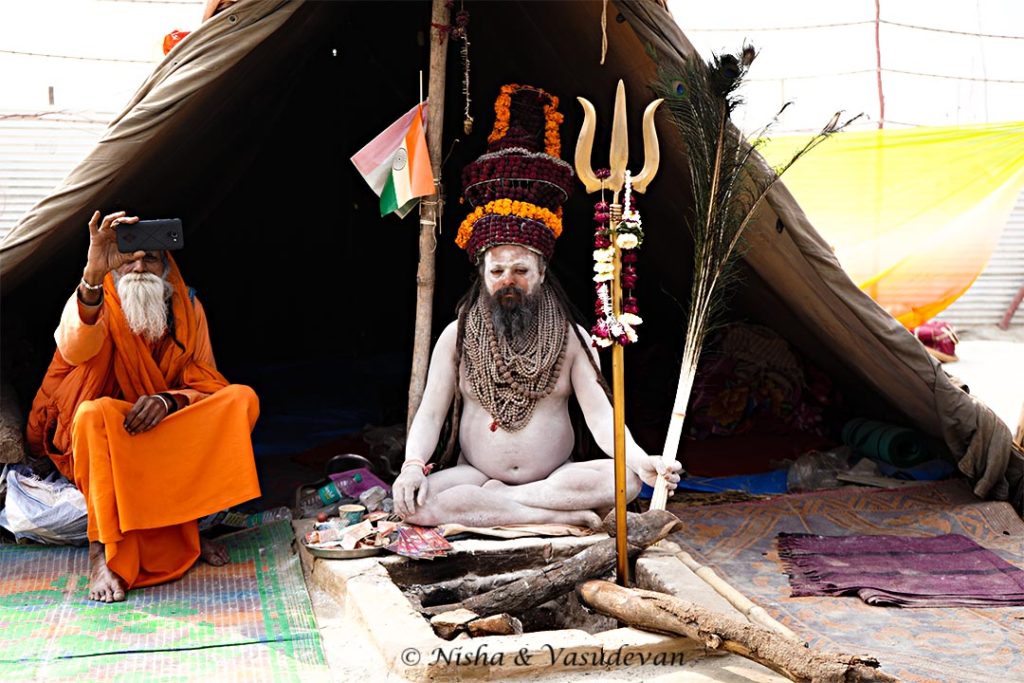
Naga Sadhu or Naga Baba, as they are also called, make themselves visible, to us lesser mortals, only during Mahakumbh Mela festival or Ardh Kumbh Mela festival. They are easily the most recognizable and popular groups of this world’s largest religious congregation of pilgrims at one place. It would not be wrong to say that this year too, like other Kumbh mela festivals in the past, many tourists from India and abroad visited the Prayagraj festival site to see and interact with the Naga Sadhus in Kumbh Mela 2019, among other activities.
We too were drawn to them during our visit to the Prayagraj Ardh Kumbh Mela 2019 because this was a rare opportunity for us to interact with the Naga Babas and appreciate these arcane Sanyasis or ascetics.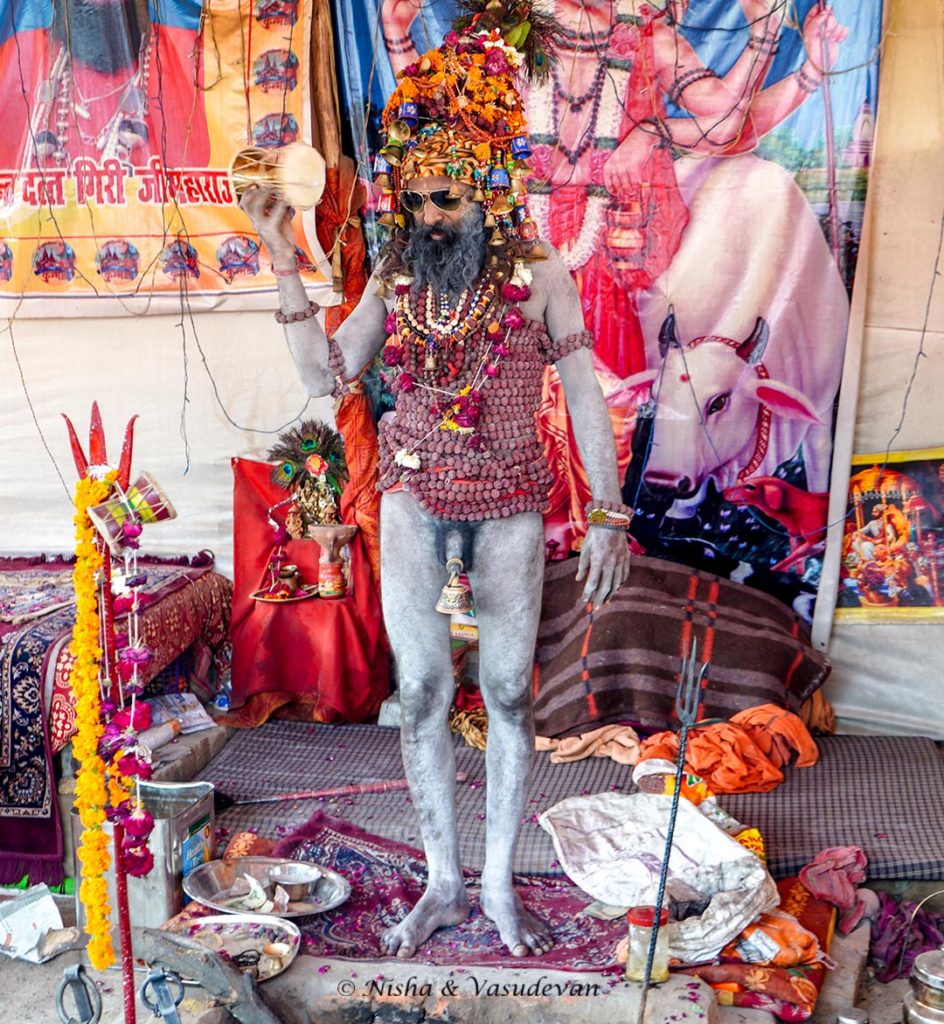
Naga Babas are also a big hit with the multi-million pilgrims who throng the banks of the confluence of the three holy rivers, Ganga, Jamuna and Saraswati. Their reasons are different. They believe that all their problems in life would go away by taking Naga Baba’s blessings.
Many times people have a wrong notion about these Naga Sadhus and are often in awe of them, bordering on fear, because of their intimidating and powerful looks. We have tried to collect as much information on Naga Babas, talking to Naga Sadhus, other Sadhus, our guides and locals.
Who is Naga Sadhu or Naga Baba?
A Sadhu (saadhu), in simple terms, is someone who spends his life doing sadhana. Sadhana is a set of religious and spiritual practices and activities involving praying meditating and penances. These practices are performed diligently to attain freedom from the eternal cycle of death and rebirth which is a concept believed in Hinduism.
The nearest English equivalent would be a religious ascetic or a monk.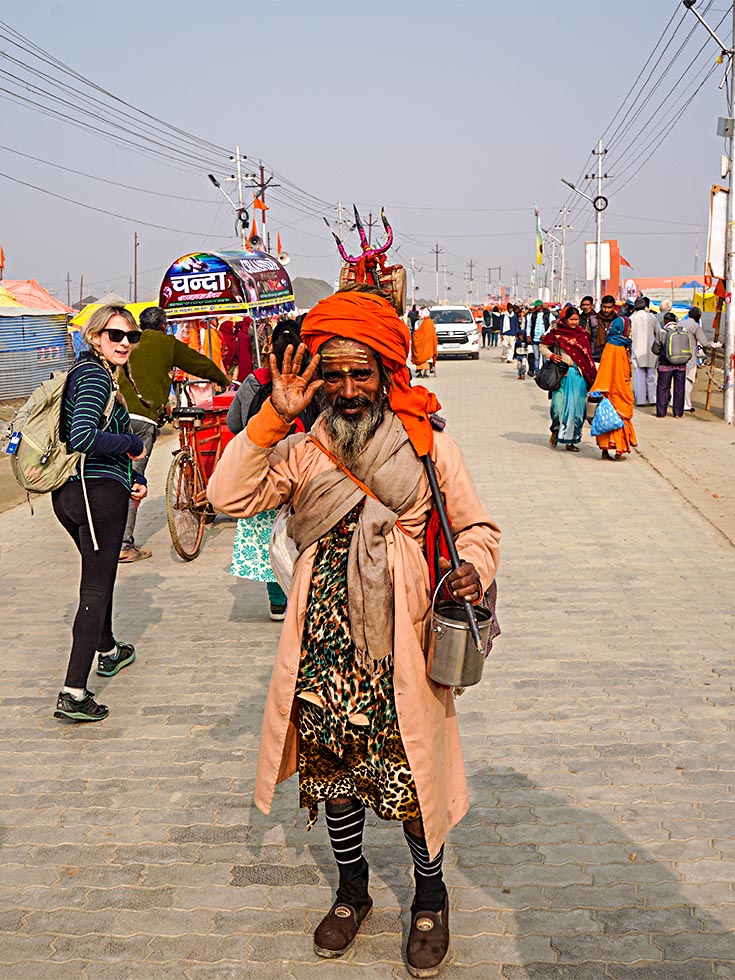
No one is born a sadhu. It is a conscious decision made by males or females (a female sadhu is called sadhvi) to renounce worldly things, including family and in their quest for Moksha (liberation from the eternal cycle of life). Most of the sadhus wear Saffron or white clothes just draped around their body. The tradition has it that they must wear unstitched clothes. So shirts, trousers, kurtas and Pyjamas are not allowed. We however met a sadhu wearing a branded hoodie. 🙂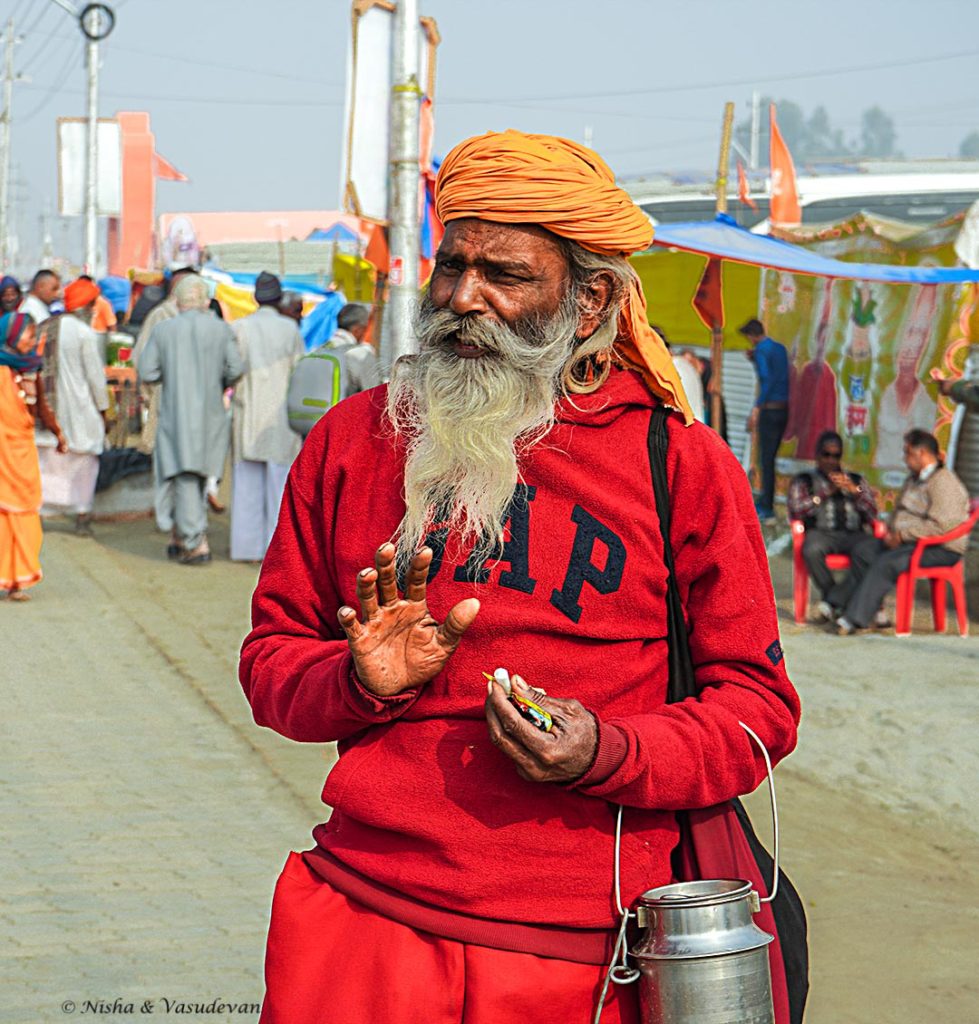
A naga sadhu is all this and more. As per one of the sadhus we met at Prayagraj Kumbh Mela 2019, once deciding to be a Naga Sadhu, a person has to formally enter one of the many Akharas (which can be assumed as a monastery where the initiation takes place). He undertakes rigorous and strenuous training under a Naga Sadhu guru for at least a decade to overcome their desires and control their mind, do hours of penance, practice yoga and many times train to use weapons. They must pass a test to be conferred the title of a Naga Sadhu. A Naga Sadhu is almost always a follower the Hindu god Shiva.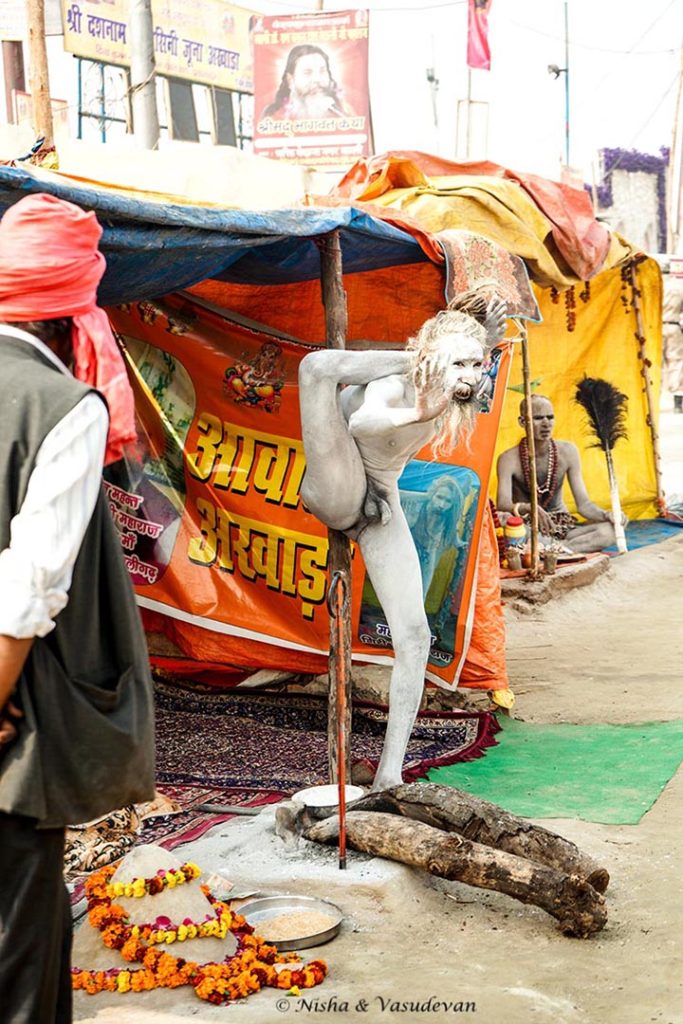
A Naga baba performing a difficult yoga posture
Hotels in Prayagraj, Allahabad
How to identify a Naga Sadhu?
They are easily recognizable as they are all ash-covered and are completely naked, devoid of any type of clothing. However many of them may have jewelry, necklaces, headdress or crowns made of Rudraksha, a seed from a type of berry tree considered holy. Some of them also wear stringed flowers around their neck. Another distinctive feature is their Jata (matted hair or dreadlocks). This is symbolic of the Hindu god Shiva, who is also depicted as having matted hair.
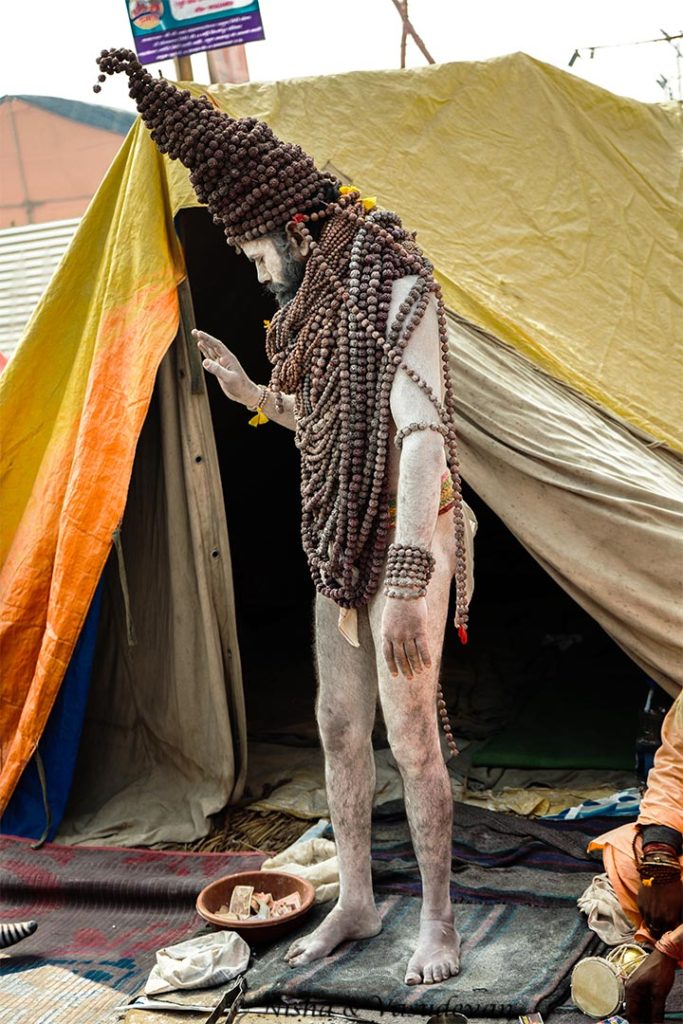
Rudraksha Naga Baba
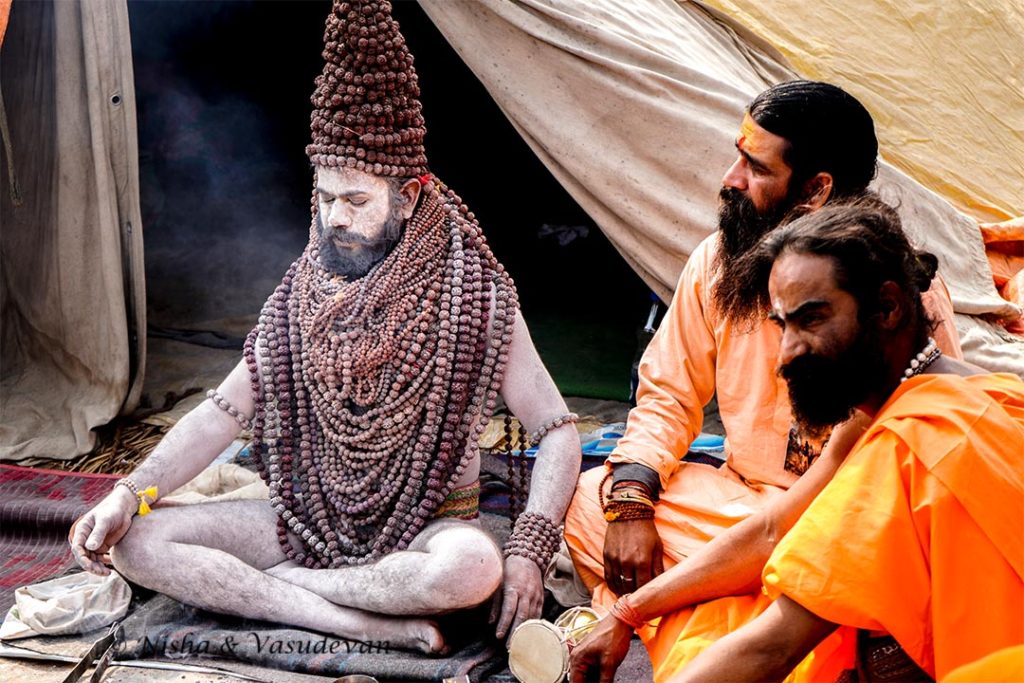
Rudraksha Naga Baba
Many of them sport an intimidating look with their trident, sword or stick, however, they are not violent, as they are thought to be. Of course, you need to take their permission before clicking their photograph. In fact, we found most are quite game for getting their photos taken. One of them even took mine in his cell phone….is he perhaps the Mobile Guru? When we were at the Kumbh meeting Sadhus, some of them even asked for money. Looks like even Sadhus and Sanyasis cannot do without money!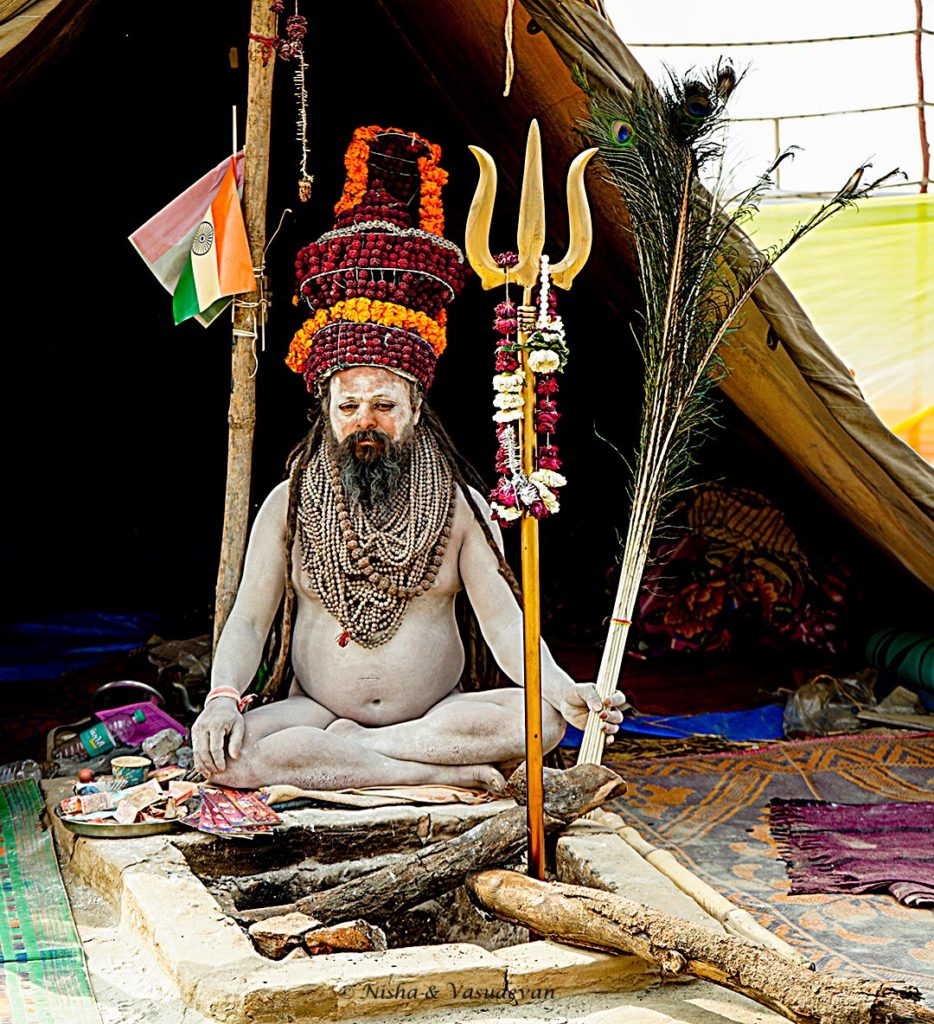
You Don’t want to mess with him!
It is better to leave those who don’t want to be photographed, alone. I found one of them threatening a tourist with his trident for clicking him. Well, it could be just the Naga Baba’s way of having a bit of fun, but it is better to be safe than have a spear stuck to your derrière. 🙂
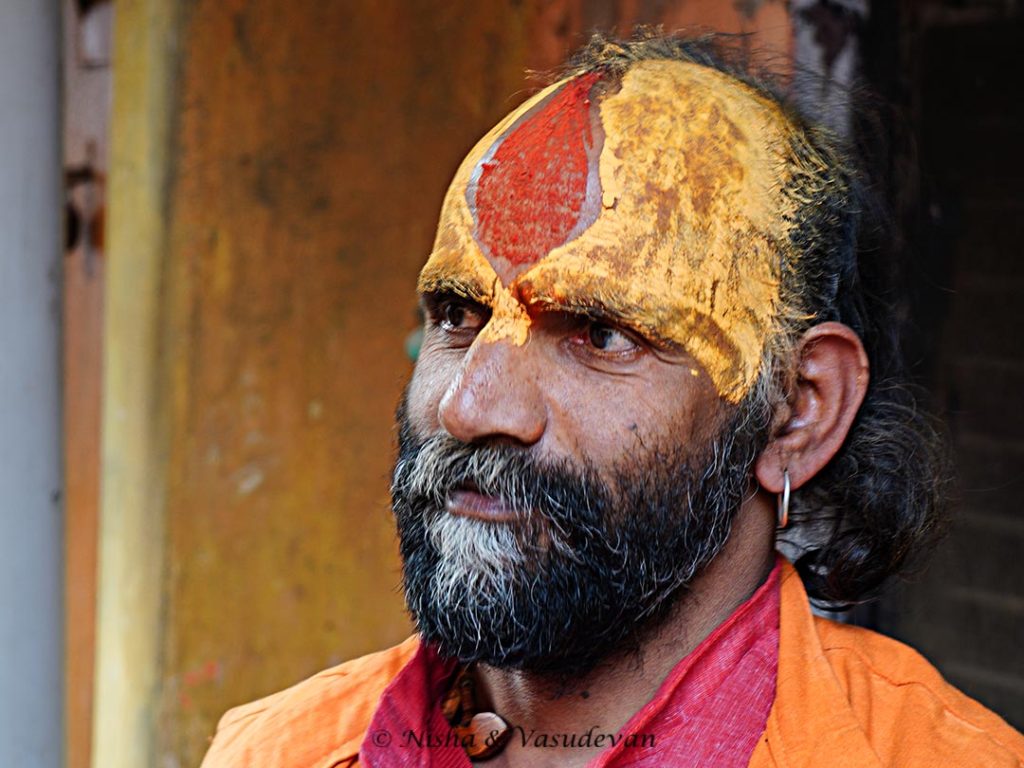
Not a Naga Sadhu
Why does a Naga Sadhu have a weapon?
In the 8th century CE, Adi Sankaracharya took it upon himself to save the Sanatana Dharma religion and its followers from attacks from foreign lands who looted, destroyed places of worship and converted people to their religion. Sanatana Dharma is more popularly called the Hindu religion nowadays.
A Naga Sadhu brandishing his trident narrated, “So Adi Sankara with his followers traveled all over India to revive Hindu religion and build more temples. He set up 4 major centres of Hinduism in the four directions. Most interestingly, he also organized the Naga Sadhus into Akharas, trained them in weaponry and wrestling. They were to be the second line of defense after the King’s Soldiers, against the enemies.
There were many historic battles fought by Naga Sadhus, but the most notable was the battle against an Afghan attack in 1757, 4 years before the Third Battle of Panipat. Having renounced everything in this world, Naga Sadhus had very little to lose in a battle. Their sheer bravery coupled with their being unafraid of death helped them successfully defend the religious city of Gokul.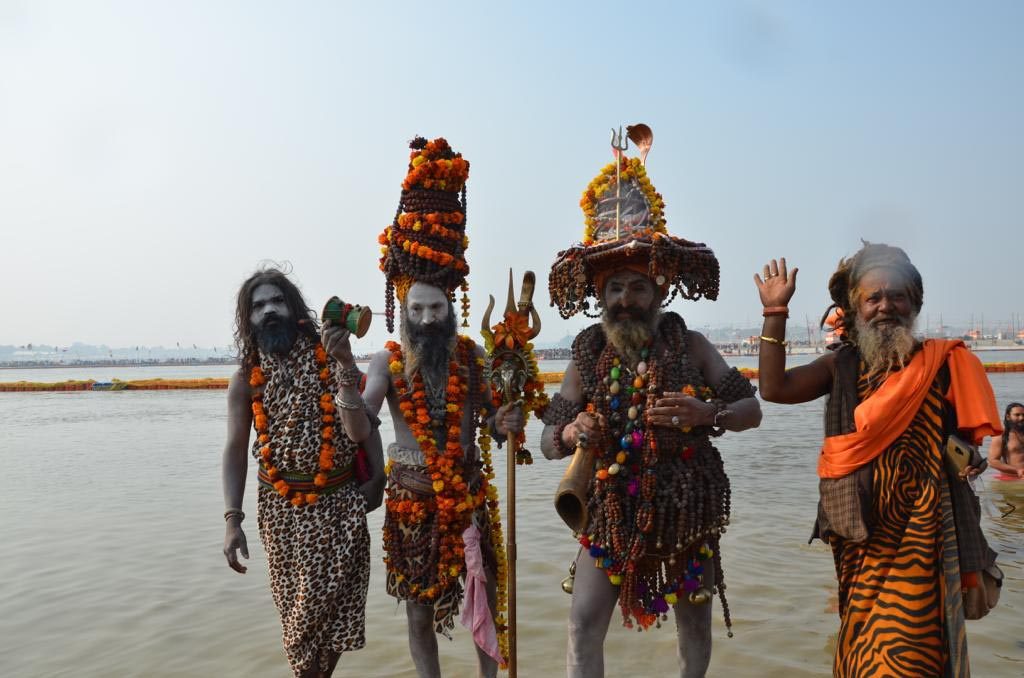
Naga Sadhus? hmmmm… Does anyone have any idea?
The trident wielding Naga Baba said, although Naga sadhus don’t fight battles any more, the tradition continues and every Naga Sadhu is trained in using trident, spear, mace, sticks and other weapons. Their are very agile due to years of practicing yoga.
Once in a while we hear their battle cry “Har Har Mahadev” showing that they are ever battle ready.
Why are they called Naga Sadhus?
Based on our conversations with many naga sadhus, there are two possibilities.
One is, it is a corruption of the Sanskrit word Nagna Sadhu, or the Hindi word Nanga Sadhu both literally meaning “Naked Sadhu”.
Other one is, that in the olden days these sadhus used to wear Nagas (snakes) around their neck, much like the god Shiva. For us both sounded equally plausible. I leave it to our readers to conjecture and let us know in the comments.
Why is a Naga Sadhu naked or devoid of any clothes?
As per a Naga Baba I met, the clothes are used to cover or protect the body. However once they have renounced everything, including their body in favour of the lord, they find clothes are of no importance and as part of their initiation into the fold, they shed their clothes.
Are there women Naga Sadhus?
The brief answer is yes. A woman Naga Sadhu is called a Naga Sadhvi. They also have to enter an Akhara and undergo the same training as meant for men except use of weapons, for more than 10 years. The difference is that they compulsorily drape a saffron cloth all around. They too come to the Kumbh mela for their ritualistic prayers.
On graduating successfully, they are give the title of “Mataji” meaning “respected mother”, irrespective of their age.
Who are Khooni Naga Baba and Barfani Naga Baba?
As per Hinduism, when a person dies, a specific havan, a form of ritualistic prayer with vedic chanting around a pit of fire, invoking the gods and good spirits, is performed by the relatives of the deceased, to ensure the soul of the departed travels safely to the heavens.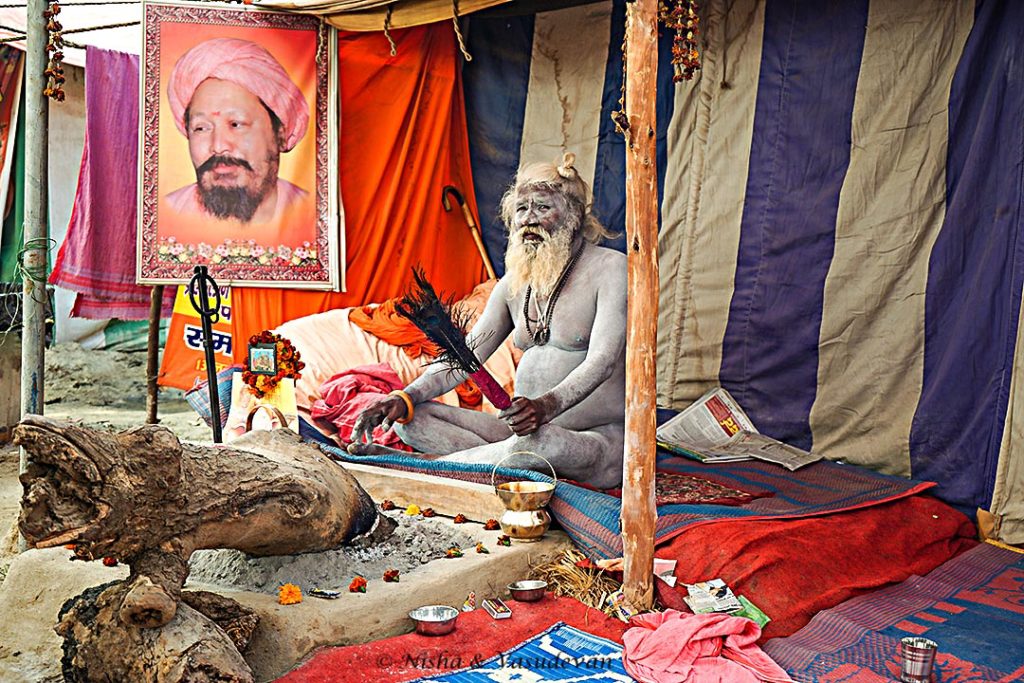
The ashes come from the burning wood while performing Havan
Once a Naga Sadhu apprentice has completed his training, he has to perform this havan for himself, under his Guru’s guidance. Meaning as far as this earth is concerned, he is dead(!). This is the final sacrifice and renunciation. This has to be done during a Mahakumbh Mela or Ardh Kumbh Mela.
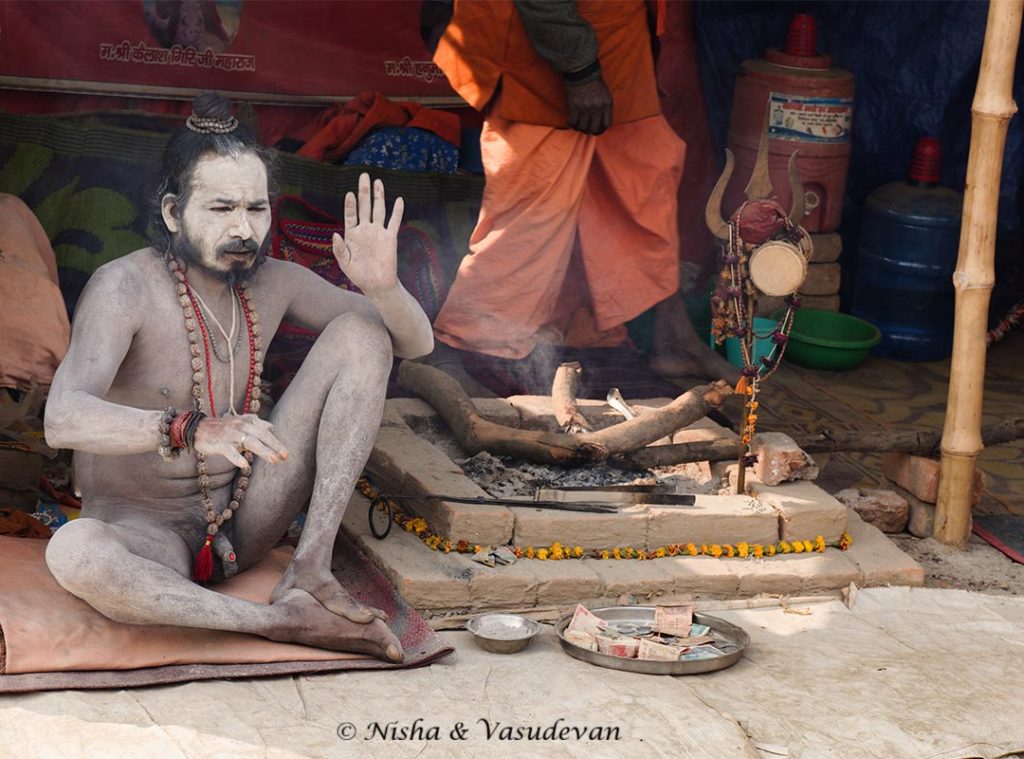
As one of the Naga Sadhu puts it aptly, “After becoming a naga we don’t even own our body which we have renounced in favour of Lord Shiva”.
At any Kumbh mela one can witness thousands of Naga Sadhu apprentice performing this initiation ritual and are ordained into their fold and eligible to be called a Naga Sadhu or Naga Baba.
Depending on where the indoctrination happens, he is called differently.
Rajaj Rajeshwar Naga, those who graduate to be a naga at Prayagraj Kumbh mela. The Prayagraj (Allahabad) Kumbh Mela is considered the king of all Kumbh Mela. It is believed, those who are ordained here achieve RajaYoga, which is the king of all yoga forms and involves the ultimate super consciousness and enlightenment.
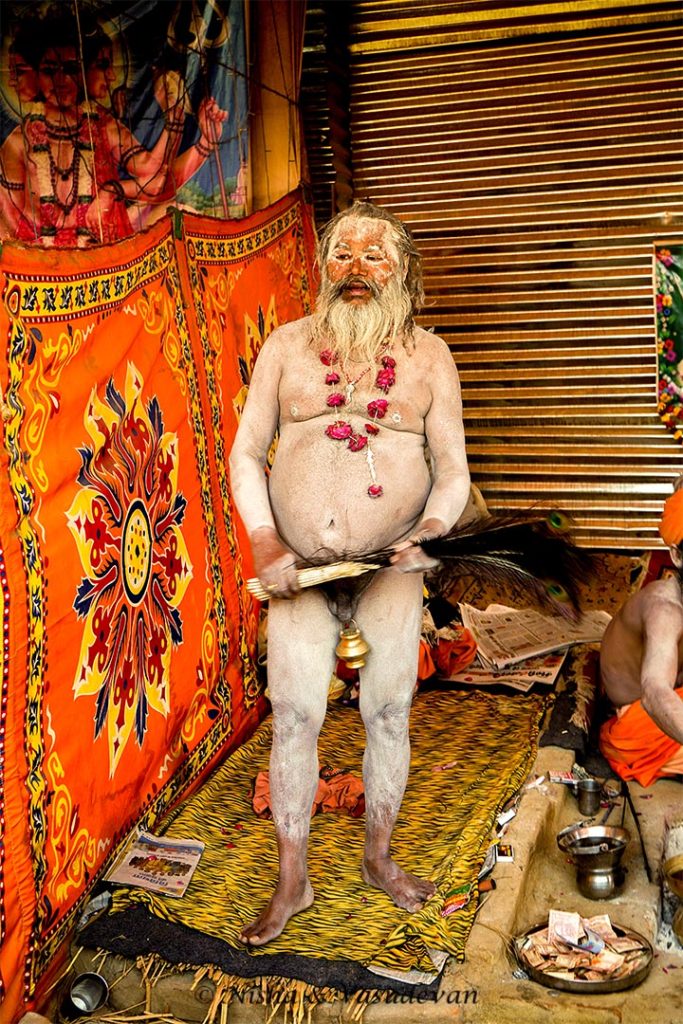
Khuni Naga at Ujjain: One of the manifestations of the God Shiva is Mahakaal. Meaning beyond time and is also the god of destruction and death. In Ujjain Kumbh Mela Mahakaal is worshipped, hence the name Khuni Naga Sadhu. In Hindi khoon means blood. These Naga Babas are also considered to be angrier and a bit violent.
Barfani Naga at Haridwar: The City of Haridwar is located at the foothills of the Himalayas. In the winter all the surrounding hills are snow-capped. In Hindi Barf means Ice or snow. These Naga Sadhu are more peaceful and gentle.
Khichdi Naga at Nashik (Nasik) Kumbh Mela: It is not known how this name was conferred on these naga sadhus.
Where does a Naga Sadhu live?
It is often said that at the beginning of Kumbh Mela, these mysterious Naga Sadhu appear on the first day as if by magic and disappear into thin air, when the Kumbh Mela festival ends and that no one knows how they travel.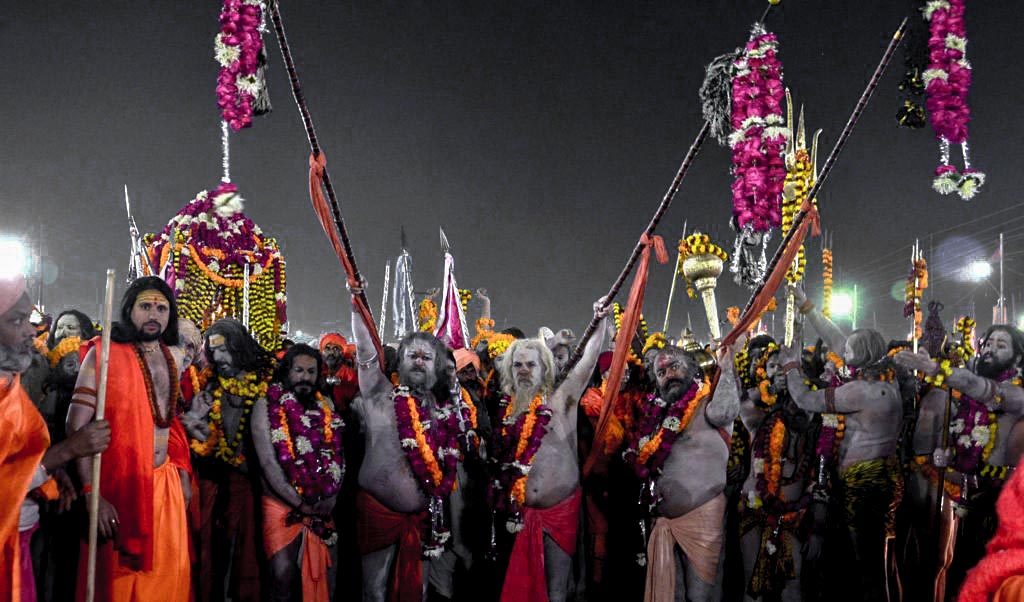
Sadhus and Naga Babas of an Akhara coming in a procession
The mystery was solved when one of them said that they preferred to travel in the dark as it is cooler and thereby cover longer distances. One of the Sadhus said jokingly, come to the bus station tomorrow, I will meet you there. 🙂
They also do not enter any city or village.
So where do they live?
As per this Naga Sadhu, most of them live in caves or ashrams or camps in the Himalayas of Uttarakhand, hills of Gujarat and Kashi (which is another name for Varanasi). All graduated Naga Sadhus may or may not live together in the same place. Often, each one will be on his own, meditating and moving from cave to cave, place to place.
They do have a mysterious way of communicating. It is surprising how they congregate and make the journey to Kumbh Mela in a group.
During Kumbh Mela a camp is set up in a designated spot for each Akhara with independent space for each Naga Sadhu.
What do Naga Sadhus eat?
A Naga Sadhu, when in the mountains and forests, eats fruits, root vegetables, herbs and such. He is supposed to eat only once a day.
When a Naga Baba is near a village he is allowed to request for their food as alms. Whatever the people give, should be accepted graciously. Anyway, they eat to live, not live to eat. 🙂 If the first 7 people refuse then he has to go hungry for the rest of the day. Most Naga Sadhus are vegetarian, however, some groups could be non-vegetarian too. Also if someone gives non-vegetarian food as alms then he has to consume it as it is.
However it would be a very rare occurrence for someone to disrespect a sadhu by offering non-vegetarian food and seek blessings.
In Kumbh Mela, it is fairly easy for them to get their food as visiting pilgrims often offer food for Naga Sadhus.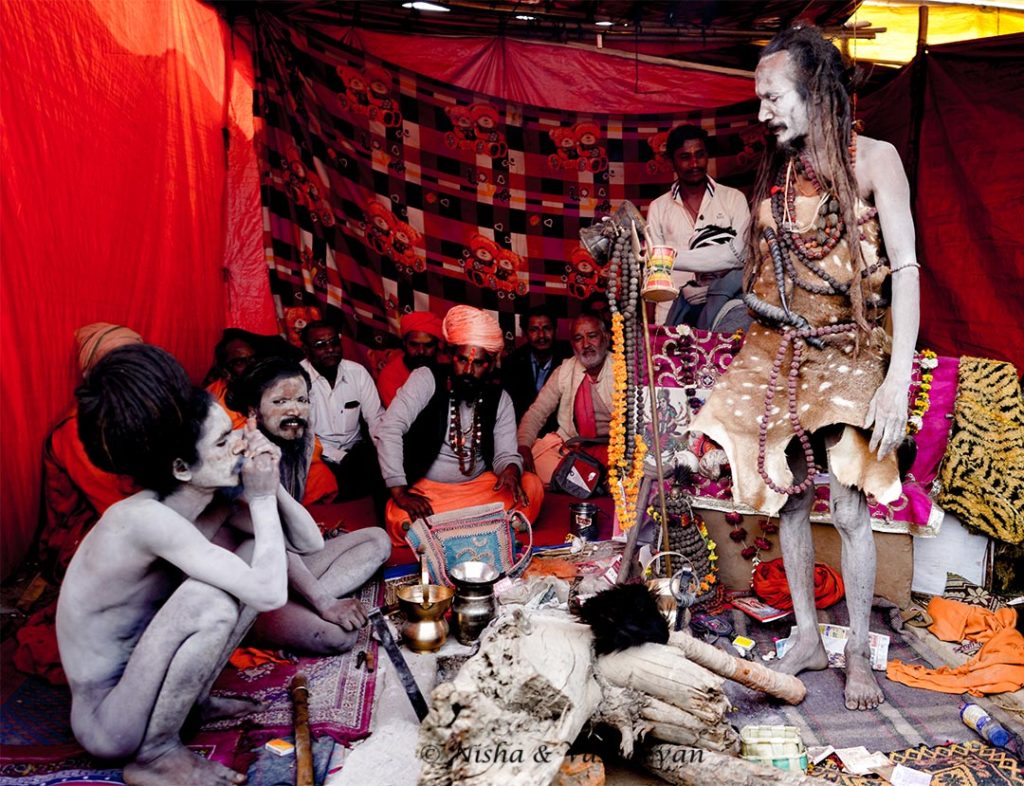
Many Naga Sadhus smoke some form of weed ir the other
Why does a Naga Sadhu come to Kumbh Mela?
As part of their vow, they are supposed to visit Kumbh Melas at least once in 12 years. During a Kumbh Mela, there are specific days which are marked for Shahi Snan or the Royal Bath. On these days the number of pilgrims is manifold more. However, the Naga Sadhus get the first right to take a dip in the holy river, before sunrise.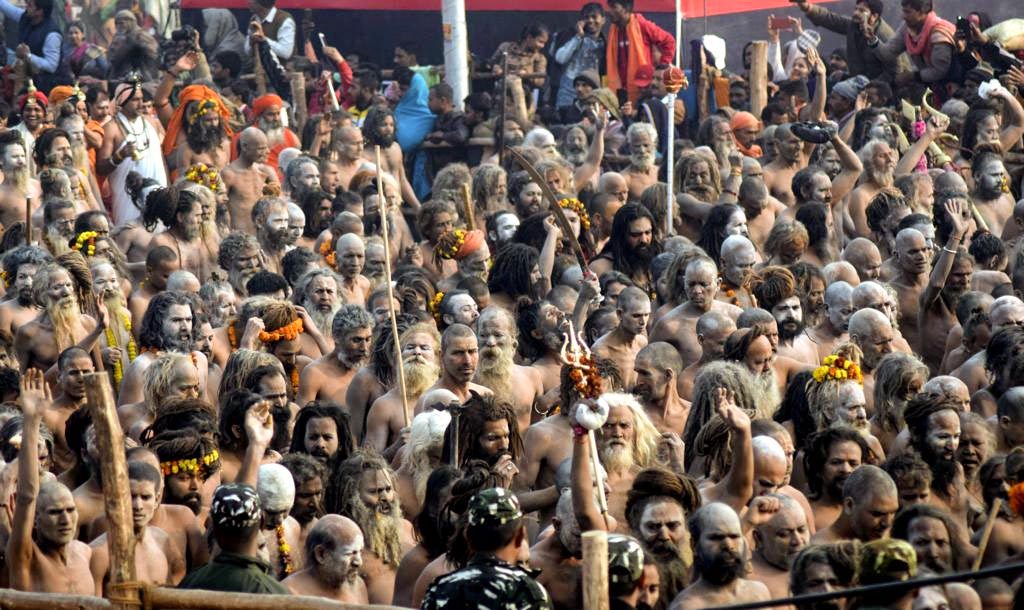
Kumbh Mela is also important for those to-be Naga Sadhus who would like to be elevated to the level of Naga Sadhus as that process can happen only during Kumbh Mela. Of late the presence of Naga Babas in Kumbh Melas has increased the tourism revenue for the government and in return, they create many facilities for the Naga Babas and the pilgrims to make their experience unforgettable.
What is an Akhara or Akhada?
An akhara is a monastic place for training and education for Sadhus, Sadhvis and Naga Babas to practice their religion and learn Indian Martial Arts and the use of weapons too.
Every Naga Sadhu belongs to an Akhara and every akhara has a guru with their own code of ethics and conduct which is mandatory for its members to follow.
Each Akhara has its own organization and has several of its members performing multiple roles and has a strict hierarchy. For example, the chief of the Akhara is called MahaMandleshwar. This year in 2019, A woman, Sadhvi Niranjan Jyoti, was made the Mahamandlleshwar of one of the oldest Akharas called Niranjani Akhara.
Every akhara has kotwal who is the go-between the Naga Sadhu and akharas and also brings to them information on festivals and Kumbh Melas as to their exact dates and venue.
Traditionally there are 13 akharas, however, this year a new akhara was instituted called the Kinnar Akhara. An akhara for the transgenders. A transgender social activist, Lakshmi Narayan Tripathi was made the Mahamandaleshwar. In her words, this recognition was long pending and had to struggle every bit of the way.
Can Naga Sadhus get married?
The very fact that they are sadhus means they have renounced all the material world and as such cannot and will not marry. Though it may be possible a few of them were married before entering the monastery for their indoctrination.
Useful Information
Tips
- Interacting with Sadhus: Take permission before clicking photos of Sadhus. Some of them hate tourists and are quite irritable. Leave them alone.
- Plan Ahead for Crowds: Kumbh Mela attracts millions of pilgrims and tourists. Plan your visit well in advance to ensure comfortable accommodations and smooth travel arrangements. Booking early will help you avoid last-minute inconveniences and ensure a more enjoyable experience.
- Follow Local Customs and Traditions: Respect the religious and cultural practices observed at Kumbh Mela. Be mindful of the rituals taking place and follow any guidelines provided by local authorities. Understanding and appreciating the traditions will enhance your overall experience and contribute to the harmony of the event.
- Stay Hydrated and Well-Nourished: The large crowds and diverse activities can be physically demanding. Carry water, snacks, and essential personal items to stay hydrated and energized throughout the day. Pay attention to your health and well-being to fully participate in the festivities.
- Comfortable Clothing and Footwear: Wear comfortable and modest clothing suitable for a spiritual gathering. Since you may need to walk long distances, comfortable footwear is crucial. Be prepared for varying weather conditions by bringing layers or protective gear such as hats and sunscreen.
- Be Security Conscious: It could get very crowded, so much so that you will have people bumping into you. Stay vigilant about your belongings in crowded areas. Consider using a money belt or pouch to keep your valuables secure. Follow the guidance of local authorities and organizers regarding safety protocols. Be aware of emergency exits and locations of medical facilities, ensuring a safe and secure visit to Kumbh Mela.
Tidbits
- Unique Spiritual Gathering: Kumbh Mela is the largest religious gathering in the world, attracting millions of pilgrims and tourists. It is held at the confluence of sacred rivers, where the water is believed to turn into nectar during specific planetary alignments.
- Frequency and Locations: The Kumbh Mela is celebrated every 12 years in rotation between four sacred locations: Prayagraj (Allahabad), Haridwar, Nashik, and Ujjain. Each location has its own unique significance and rituals.
- Ardh Kumbh and Maha Kumbh: In addition to the main Kumbh Mela, there are smaller gatherings known as Ardh Kumbh (every six years) and Maha Kumbh (every 144 years). The Maha Kumbh is considered especially auspicious and attracts an even larger congregation.
- Diverse Sadhus and Sects: Kumbh Mela is a meeting ground for various sects of sadhus (holy men) and spiritual leaders, each with its own distinct traditions and practices. The event provides a rare opportunity to witness this diversity.
- Shahi Snan – Royal Bathing Procession: The highlight of Kumbh Mela is the Shahi Snan, a royal bathing procession where revered sadhus and saints take a dip in the holy river. This is considered a spiritually significant act believed to cleanse sins.
- Cultural and Religious Programs: Alongside the religious rituals, Kumbh Mela hosts cultural events, discourses, and performances. These activities showcase the rich tapestry of India’s cultural and spiritual heritage.
- Temporary City Infrastructure: The scale of Kumbh Mela requires extensive temporary infrastructure, including makeshift bridges, tents, and medical facilities. The temporary city accommodates the massive influx of visitors during the festival.
- Akharas – Meeting Grounds for Sadhus: Akharas are designated areas where different sects of sadhus camp during the Kumbh Mela. Each Akhara has its own specific rituals, and visitors can witness the sadhus practicing their traditions.
- Massive Processions and Parades: The Kumbh Mela features grand processions and parades, with sadhus on chariots, elephants, and horses. The atmosphere is vibrant and filled with devotional fervor.
- Environmental Conservation Initiatives: In recent editions, there has been a focus on environmental sustainability. Efforts are made to minimize the ecological impact of the event, including waste management and conservation programs. Visitors are encouraged to be environmentally conscious during their stay.
- There are about 400,000 Naga Sadhus in India!
- In 2019 , almost 5 crores (50 million) pilgrims attended Kumbh Mela.
- There are 3 other Kumbh Melas that are almost as important and held in Haridwar, Nashik and Ujjain.
Best places to stay in Prayagraj
You will find great Hotels in Prayagraj, Allahabad suiting all budgets
Pin it!
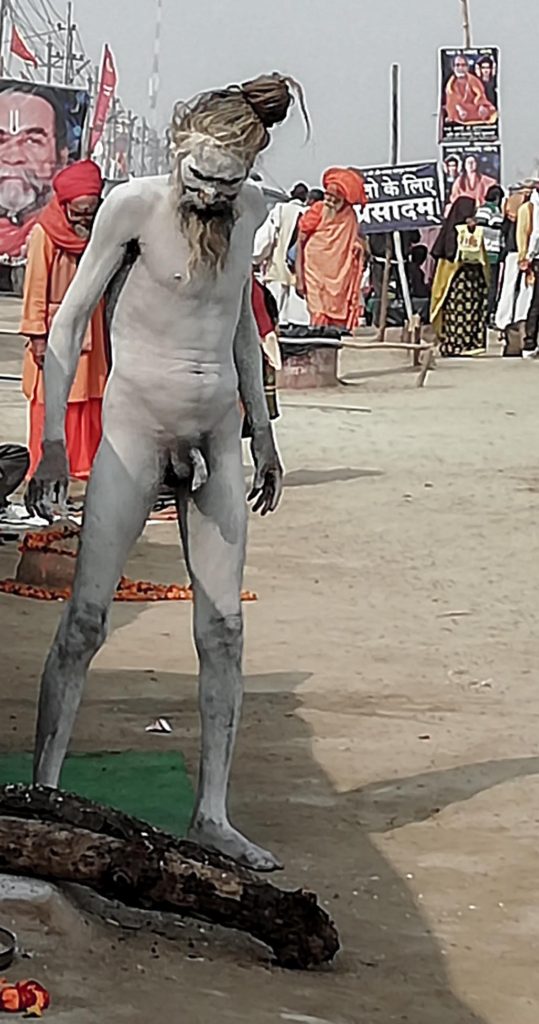
Copyright Information
All photographs used in this article belong to Nisha Jha &, Vasudevan who are the owners of this site www.lemonicks.com. Copying or using them without explicit permission is prohibited and will amount to copyright infringement.
If you want to travel places with us, we invite you to join us on our feed or Facebook Travel Page.
P.S.- This article, Naga Sadhus in Kumbh Mela, Prayagraj, belongs to Le Monde, the Poetic Travels, an Indian Travel Blog, published by the traveling couple, Nisha & Vasudevan. Reproduction without explicit permission is prohibited. If you are viewing this on another website rather than the RSS feed reader or www.lemonicks.com itself, then that website is guilty of stealing our content. Kindly do us a favour by letting us know via Contact Us. Thank you.
#lemonicks-in07
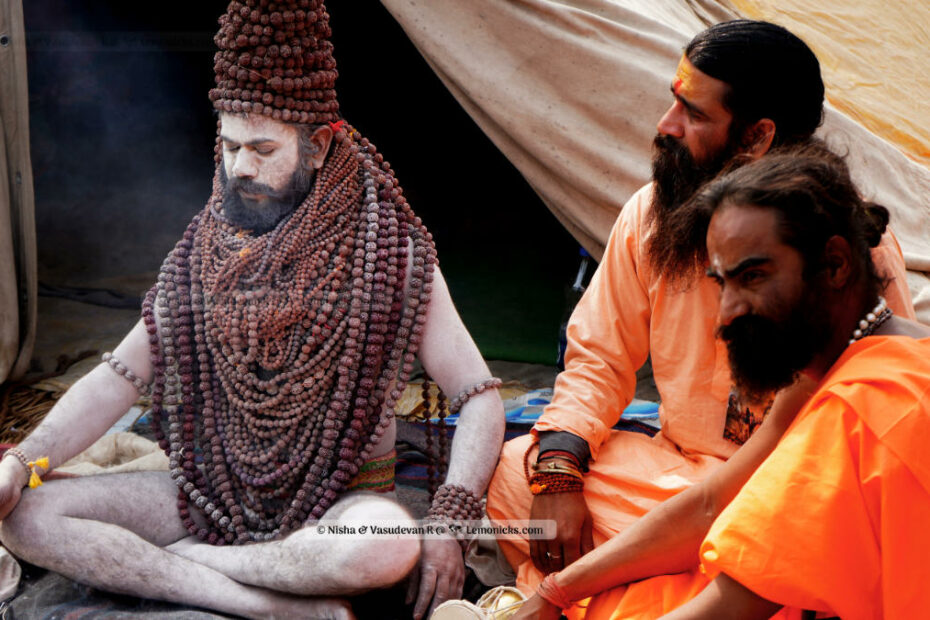
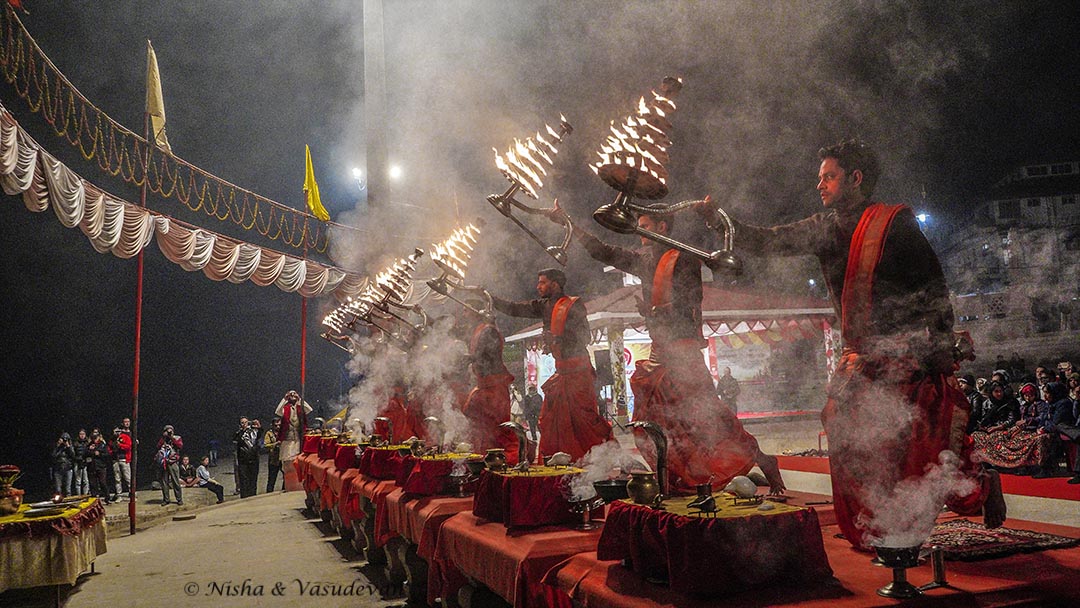

Wow ! I did not know so many things about Nanga sadhus.
Always looked upon them as some alien, now I know why they are what they are.
Thanks for sharing.
What a fascinating article. This was all so far away from my norm and world view. That’s one of the things I love about travelling and travellers. You get to break out of your shell and see the world through another’s eyes.
OMG I didn’t know about Naga Sadhus or Naga Babas and the Mahakumbh Mela Festival where they appear. The photos of them look so unreal and your account is so interesting!
I know very little about Hinduism. This article is very interesting and taught me a lot about one of the world’s great religions.
I’m with Jenn and Ed… fascinating article. I think I’d have difficulties NOT gawking a bit though. Some of those body piercing are a bit eye catching. Are they painful you think?
It sounds like the Naga Sadhu have a really healthy vegetarian diet, but I don’t fancy the idea of eating once a day, or going without sometimes. Cutting down on meals is definitely my weakness at the moment
Oh what a fun trip we had! It certainly was an eye opener seeing the Naga Sadhus at the Kumbh Mela. One of those experiences that I’ll never forget.
I definitely learned a lot. And saw more naked people than I expected! What a surprise! Thank you for putting together this handy guide. I’ve traveled through India quite a few times and met some folks who have called themselves babas but none who have gone this far! I always wondered about the background of the naked ashy holy men. Thanks for the new in-depth understanding and some new yoga poses to try! Thanks for sharing!
There seem to be quite a lot of the Naga Sadhus. If they only appear during these two festivals, what do they do and where do they go for the rest of the year? How do they make a living?
I think I’d feel a bit awkward seeing them. As a Westerner, we’re not accustomed to nudity like this. Some of those piercings are hard not to stare at.
Wow that is so interesting and I love that you always ask permission first to take a photo. Such a fun trip!
I was living in Allahabad when the Maha Kumbh happened a few years ago and although I am an atheist myself, I visited only to experience the vibe of the place. I remember seeing a lot of Naga Sadhus at the time and being curious about them. You’ve done extensive research and its interesting to read about it. I did not know that they had to go through more than a decade of intensive training to become a naga sadhu and also that women could also be, I have never seen a woman naga sadhvi!
Wow! Actually knew nothing of Naga Sadhus until I just read this and learnt a heck of a lot from this blog. Not sure on the testicle piercings mind you, to me thats painful. And I honestly thought there would be more than two festivals for these folk. (I know they like a good old festival in Asia compared to my little island in Europe). 😀
Wow I had never known about all of this. I had seen photos or a video with an Naga Sadhus in a scene but never knew the meanings and stories behind them.
Wow what colourful pictures! It must have been such a great cultural experience. I have not heard of Naga Sadhu before so I found that very interesting.
Very informative article. I went into q junq akhara at the Haridwar kumbh in 2010. I met many sadhus and matajis and spoke to them at length.
You have touched almost every query and topic regarding them.. and it is authentic.
I also saw them worshipping 2 huge piles of rusted weapons, unused. It’s true that they have a history of warrior monks. But they are not violent, rude or aggressive unless someone deliberately invades their space or insults them.
Most of the stories and apprehension about them is about myths and mystery.
jai shri ram